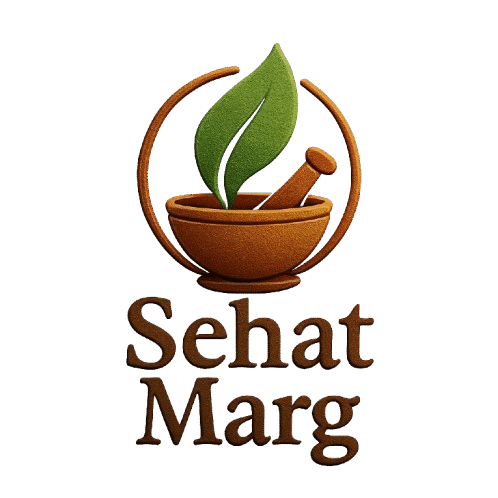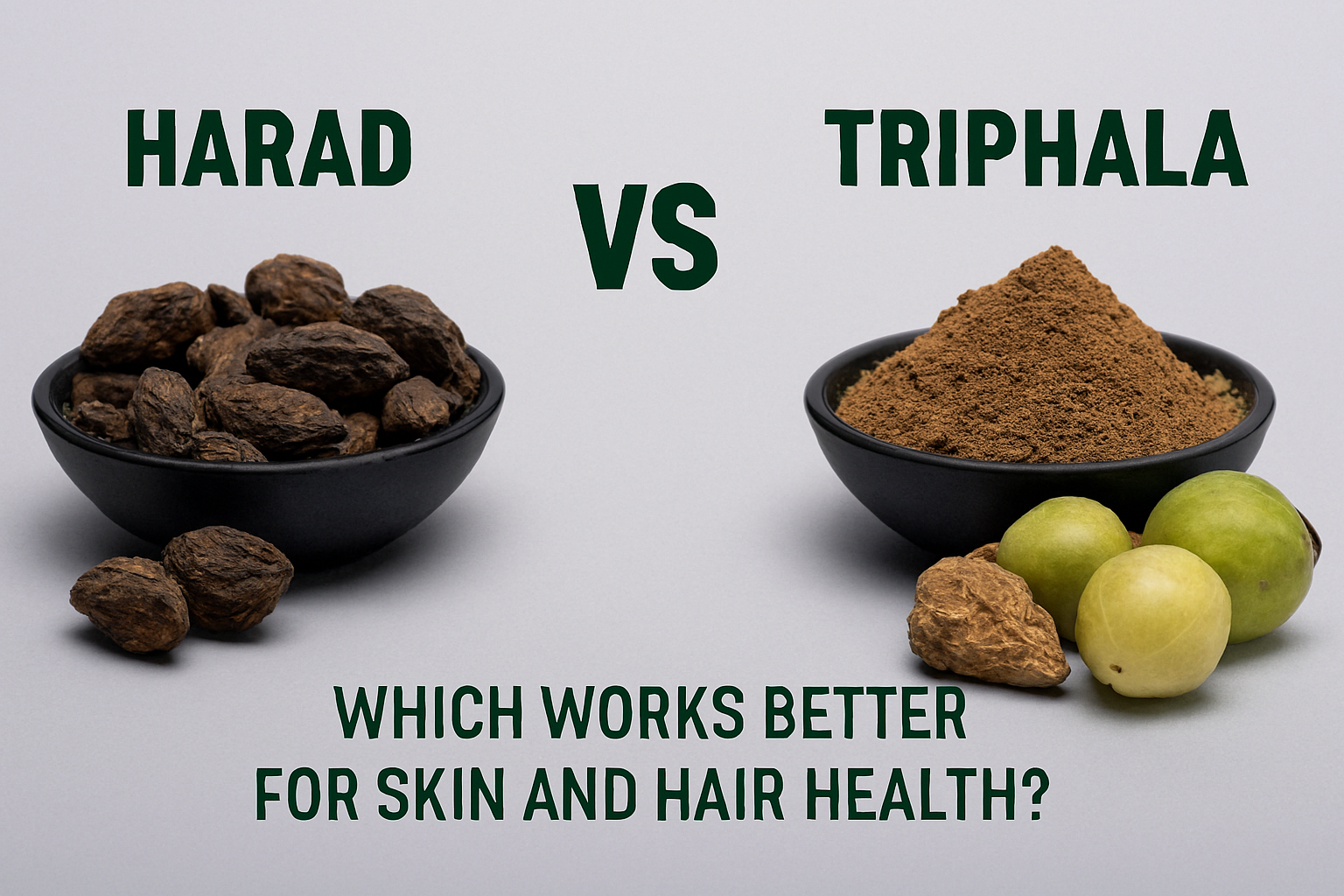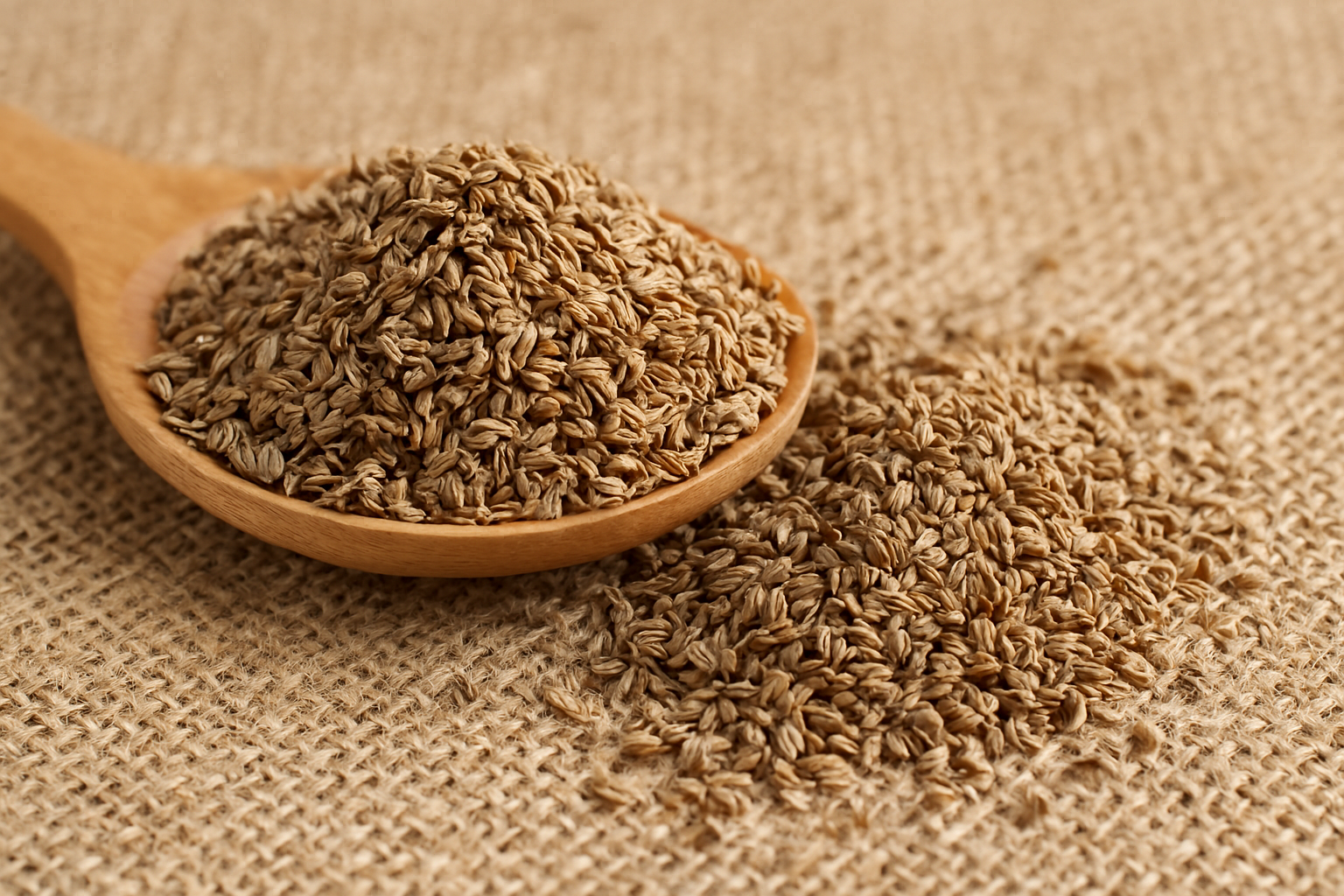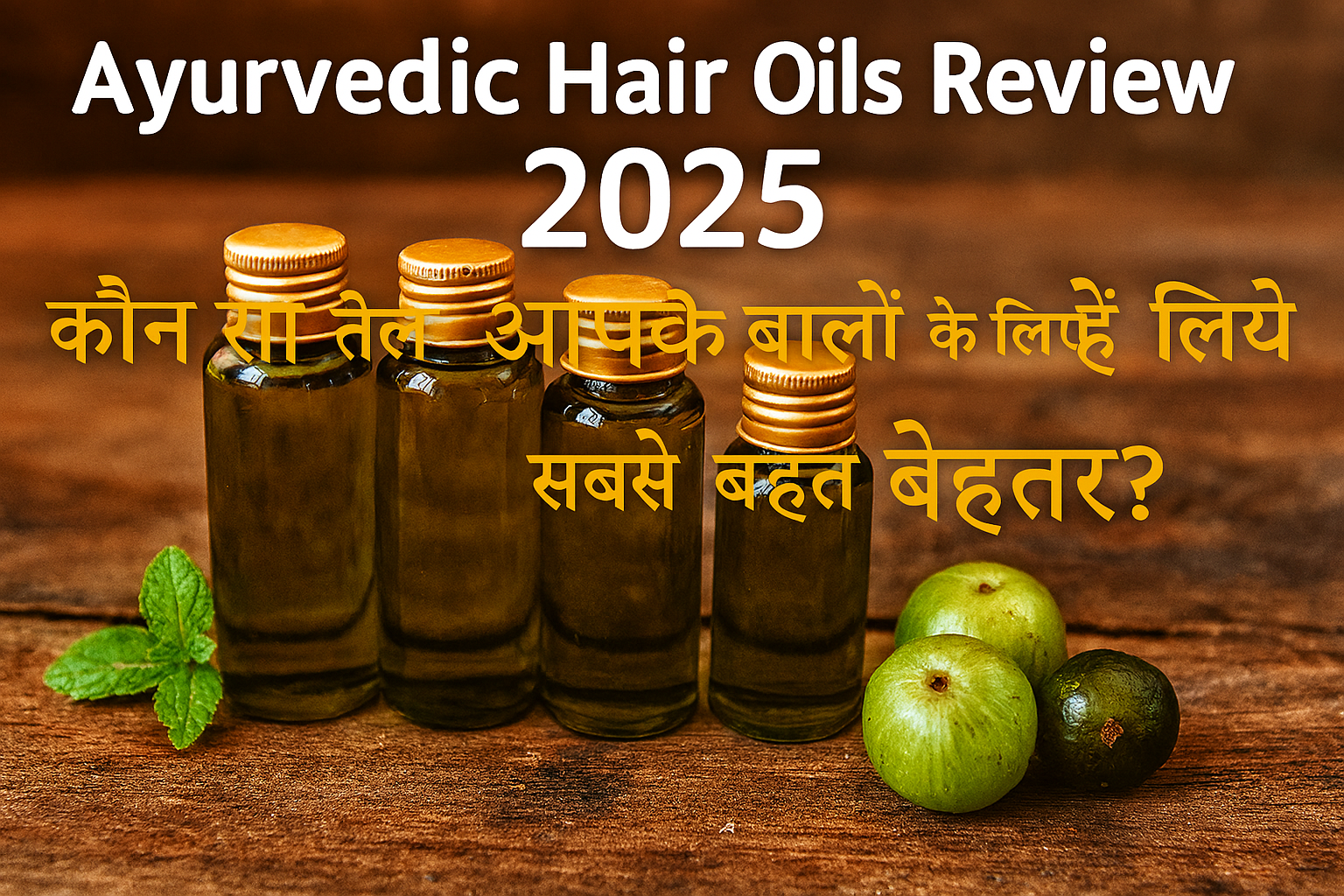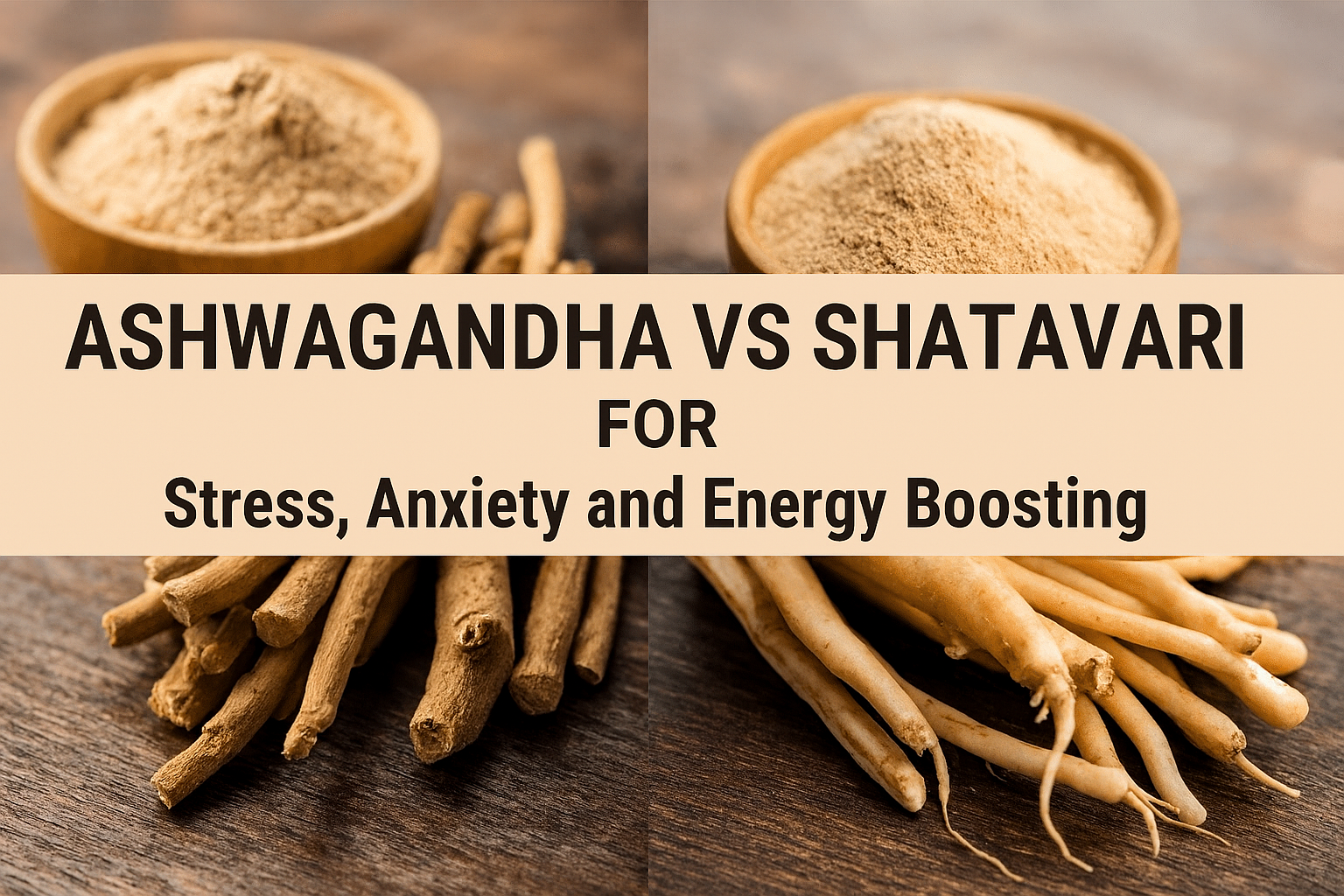Introduction: The Ayurvedic Dilemma — Harad or Triphala?
If you’ve explored Ayurveda for glowing skin or strong, lustrous hair, you’ve likely come across two celebrated herbs — Harad (Haritaki) and Triphala. Both are ancient Ayurvedic remedies known for their detoxifying, rejuvenating, and healing powers, yet they differ in composition and benefits.
But when it comes to skin and hair health, which one truly works better — Harad or Triphala?
In this article, we’ll break down their Ayurvedic properties, scientific backing, benefits, and practical uses. We’ll also share real-world experiences, expert insights, and DIY remedies that actually work — so you can make an informed choice for your beauty routine.
Understanding the Basics: Harad vs Triphala
🔸 What is Harad (Haritaki)?
Harad, also known as Haritaki in Sanskrit, is a fruit from the Terminalia chebula tree — revered as the “King of Medicines” in Ayurveda. It is one of the three fruits used to make Triphala, but on its own, Harad offers unique cleansing and rejuvenating benefits.
- Rasa (Taste): Bitter, astringent, and sweet
- Guna (Qualities): Light and dry
- Dosha Balance: Balances Vata, Pitta, and Kapha
- Ayurvedic Texts Reference: Mentioned in Charaka Samhita and Sushruta Samhita for detoxification and tissue rejuvenation.
🔸 What is Triphala?
Triphala is a combination of three fruits — Harad (Haritaki), Amla (Emblica officinalis), and Bahera (Terminalia bellirica). Together, they form a synergistic formula known for detoxifying the digestive system, improving skin glow, and strengthening hair.
- Rasa: Sour, sweet, bitter, and pungent
- Dosha Balance: Balances all three doshas (Tridoshic)
- Ayurvedic Reference: Used as a Rasayana (rejuvenator) in both preventive and curative Ayurvedic therapy.
Harad Benefits for Skin Health
Harad is primarily valued for its cleansing and anti-aging properties. Ayurveda describes it as Vayahsthapan — meaning “age-defying.”
🌼 1. Detoxifies Skin from Within
Harad helps remove ama (toxins) from the body, a root cause of dull skin, acne, and pigmentation.
Practical Insight: Ayurvedic practitioners often prescribe Harad powder at night with warm water for internal detox — which can lead to visibly clearer skin within weeks.
🌼 2. Reduces Acne and Pigmentation
Its antibacterial and anti-inflammatory properties help control pimples, dark spots, and skin irritation.
A study published in Phytotherapy Research (2020) highlighted Haritaki’s potential in reducing Propionibacterium acnes — a key acne-causing bacteria.
🌼 3. Promotes Natural Glow and Even Tone
Regular use (internally or as a face mask) improves blood purification, promoting a healthy, natural glow.
DIY Tip:
Mix 1 tsp Harad powder + 1 tsp Multani Mitti + Rose water.
Apply as a face mask once a week for tan removal and even tone.
🌼 4. Anti-Aging and Skin Tightening
Harad contains antioxidants like tannins and flavonoids, which help combat free radicals — the main culprits behind wrinkles and premature aging.
Harad Benefits for Hair Health
🌿 1. Stimulates Hair Growth
By improving digestion and nutrient absorption, Harad supports healthy hair follicles from within.
It also helps cleanse the scalp when used topically.
🌿 2. Fights Dandruff and Scalp Infections
Due to its antimicrobial properties, Harad can prevent fungal infections and dandruff — making it a great Ayurvedic scalp cleanser.
DIY Hair Pack:
- 1 tbsp Harad powder
- 1 tbsp Amla powder
- Add coconut oil to make a paste
Apply for 30 minutes and rinse for dandruff-free hair.
🌿 3. Prevents Hair Fall and Premature Greying
Harad balances Vata dosha, reducing dryness of the scalp — a common cause of hair thinning and greying.
Regular consumption or oiling can help maintain natural hair color and strength.
🌼 Triphala Benefits for Skin Health
Triphala, being a combination of Amla, Harad, and Bahera, provides comprehensive skin rejuvenation.
🍋 1. Boosts Collagen and Skin Elasticity
The Vitamin C-rich Amla in Triphala enhances collagen production, promoting youthful and plump skin.
Triphala’s antioxidants reduce oxidative stress — a key aging factor.
🍋 2. Brightens and Evens Skin Tone
Triphala acts as a natural exfoliant and detoxifier, helping reduce pigmentation and sun damage.
In Ayurvedic beauty therapy, Triphala face packs are known to rejuvenate dull, tired skin.
DIY Face Pack:
- 1 tsp Triphala powder
- ½ tsp honey
- Few drops of lemon juice
Apply for 15 minutes, then rinse with lukewarm water.
🍋 3. Helps with Acne and Inflammation
Triphala’s antibacterial and anti-inflammatory properties can reduce acne and redness without drying out the skin.
It also helps balance Pitta dosha, reducing internal heat that often triggers skin breakouts.
Triphala Benefits for Hair Health
💫 1. Strengthens Hair Roots
Triphala nourishes hair follicles with iron, vitamin C, and essential minerals, promoting strong and resilient hair.
💫 2. Promotes Hair Growth
Triphala improves blood circulation to the scalp, encouraging growth of thicker and longer hair.
A study published in the Journal of Ayurveda and Integrative Medicine (2019) noted that regular use of Triphala oil improved hair texture and scalp health.
💫 3. Controls Dandruff and Itchiness
Triphala’s antibacterial qualities cleanse the scalp and reduce dandruff naturally.
Tip: Rinse your hair once a week with Triphala water (soaked overnight) for a clean, refreshed scalp.
💫 4. Prevents Premature Greying
Thanks to Amla and Bahera, Triphala supports melanin production, helping retain natural hair pigment longer.
⚖️ Harad vs Triphala: Which Works Better for Skin and Hair?
| Feature | Harad (Haritaki) | Triphala (Harad + Amla + Bahera) |
|---|---|---|
| Main Role | Detoxifier, cleanser | Rejuvenator, nourisher |
| Skin Benefits | Detoxifies, clears acne, anti-aging | Brightens, tightens, anti-pigmentation |
| Hair Benefits | Reduces dandruff, supports growth | Prevents greying, strengthens roots |
| Best For | Oily, acne-prone, toxin-affected skin | Dull, pigmented, aging skin |
| Dosha Focus | Balances Vata & Pitta | Balances all three Doshas |
| Ideal Usage | Harad powder or paste (weekly) | Triphala churna or water rinse (bi-weekly) |
Verdict:
- If your main concern is acne, dandruff, or detoxification, go for Harad.
- If you’re seeking overall glow, anti-aging benefits, or long-term nourishment, Triphala is the better choice.
- For holistic results, many Ayurvedic practitioners recommend using both in rotation — Harad for cleansing, Triphala for rejuvenation.
🧘♀️ Real-Life Experiences & Ayurvedic Insights
In Ayurvedic clinics like Kerala Ayurveda and Patanjali Wellness, practitioners often combine Harad and Triphala therapies.
For instance:
- Case Study (Ayurvedic Beauty Routine):
A 32-year-old woman with hormonal acne and dull skin began consuming Harad powder at night and applying Triphala face packs twice a week. Within 45 days, she noticed a significant reduction in acne and improved glow. - Ayurvedic Insight (Expert View):
Dr. Rekha Radhamony (BAMS) notes that “Haritaki cleanses at the cellular level, while Triphala rejuvenates. When used together, they support both external beauty and internal wellness.”
🌼 How to Use Harad and Triphala for Best Results
1. Internal Use (for Detox and Hair Health)
- Harad: ½ tsp Harad powder with warm water before bedtime.
- Triphala: 1 tsp Triphala churna with honey in the morning or before bed.
2. External Use (for Skin and Hair)
- Face Pack: Triphala + honey + rose water.
- Hair Mask: Harad + Amla + coconut oil.
- Hair Rinse: Boil Triphala in water, cool, and use post-shampoo.
3. Product Options
- Brands: Baidyanath, Himalaya, and Organic India offer authentic Harad and Triphala powders.
Always check for “certified organic” labels to ensure purity.
💬 Expert Tip: Combine Harad & Triphala Wisely
For best Ayurvedic beauty results:
- Use Harad (internal) for 2–3 weeks for deep detox.
- Follow with Triphala (internal and external) for 2–3 weeks for nourishment.
- Cycle the two every few months for sustained glow and hair health.
🧴 Precautions
- Avoid overuse — excessive Harad may cause dryness.
- Consult an Ayurvedic doctor if you’re pregnant or taking medication.
- Always use high-quality, tested herbal powders.
🪷 Conclusion: Balance Cleansing with Nourishment
When it comes to Harad vs Triphala for skin and hair, it’s not about competition — it’s about balance.
Harad detoxifies, clears, and purifies — acting as your skin’s deep cleanser.
Triphala rejuvenates, nourishes, and restores — acting as your body’s natural beautifier.
Together, they form an Ayurvedic powerhouse duo that supports both inner health and outer radiance.
❓FAQ: Harad vs Triphala for Skin and Hair
Q1. Can I use Harad and Triphala together?
Yes. Harad cleanses while Triphala rejuvenates — together, they create a holistic beauty regimen.
Q2. Which is better for acne-prone skin?
Harad works best for acne and oily skin due to its detoxifying and antibacterial action.
Q3. Is Triphala safe for daily use?
Yes, in small amounts (½–1 tsp/day). It’s gentle, nourishing, and supports digestion and detox.
Q4. Can I apply Harad powder directly on my face?
Yes, mix it with rose water or aloe vera gel to reduce dryness and irritation.
Q5. How long before results appear?
Visible improvements in skin glow and hair texture usually appear in 4–6 weeks with consistent use.
If you found this guide helpful, share it with someone exploring natural Ayurvedic skincare.
For more in-depth guides on herbs like Amla, Shatavari and Ashwagandha, check out our related posts or follow our Ayurvedic wellness updates.
